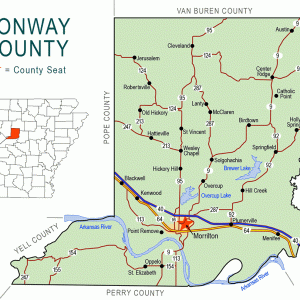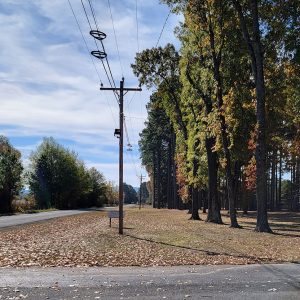calsfoundation@cals.org
St. Elizabeth (Conway County)
St. Elizabeth in Conway County is a small unincorporated community located on State Highway 154, about eight miles south of Morrilton (Conway County) and near Oppelo (Conway County) in Martin Township. The farming community, originally settled by German Catholic immigrants, is bounded on the north by the Arkansas River. It was named in honor of a thirteenth-century Hungarian saint who, though born into royalty, committed her life to working with the poor and sick.
The first white settlers to the area were members of the Bahr family, who established the community in 1874. The Joseph and Julia Hoyt family arrived about four years later. Within the next few years, other families moved to the area, attracted by the fertile farmland. Many of the settlers herded cattle, raised dairy cows, cultivated cotton and vegetables, and cut timber.
In the early 1880s, in an effort to encourage more settlement, the Little Rock–Fort Smith Railroad deeded a few acres of land to the Catholic diocese for the purpose of establishing a church. Within a short time, a church building was opened for services. Father Felix Rumpf, pastor at St. Boniface Church in the nearby St. Boniface Colony of Perry County, had previously been assigned to take the parish as a mission. Before the church opened, Father Rumpf conducted mass in local residences.
A school was also established about the time the church was occupied. Some of the Sisters of Mercy from Mount St. Mary Academy in Little Rock (Pulaski County) operated the school. Those early sessions provided an opportunity for an education regardless of students’ religious beliefs. In 1923, the original church building became a part of the school, and a seven-room convent building was constructed to house the students and the sisters. At that time, the school began accepting female boarding students. The curriculum consisted of a basic education, but religious instruction was offered to those requesting it.
The Great Depression of the 1930s had a major economic impact on the community, with many residents moving to search for better opportunities. Even with the economic setbacks, the school continued to prosper, with a new larger two-room building being occupied in 1929. The school operated for approximately twenty-one more years. By the end of World War II, enrollment—which usually numbered about fifty—could not sustain the school. In 1948, the Sisters of Mercy withdrew from the school. After being operated by a lay teacher for about two years, the school was closed. Grade school students were bused to Oppelo; some high school students went to Morrilton (Conway County), with others attending Morrilton’s Sacred Heart Catholic School.
A new church was built in 1917, and a priest rectory was built on the church grounds in 1928. Over the years, several priests ministered to the congregation. Father Lawrence Maus, who served the parish for several years, designed a new church building, which was dedicated in 1964. About ten years later, a parish hall was added to the church complex. The church remains active in the twenty-first century.
By the 1950s, the church had lost its priest and had become a mission parish administered by the St. Boniface Church in New Dixie (Perry County). Today, the church is located on St. Elizabeth Road and has an Oppelo address. St. Elizabeth, which by the beginning of the twenty-first century was home to about 100 people, remains a farming community.
For additional information:
Conway County Heritage: Then and Now. Nashville, TN: Turner Publishing Company, 2006.
Conway County Historical Society. Conway County: Our Land, Our Home, Our People. Little Rock: Historical Publications of Arkansas, 1992.
Trower, Kathy. “St. Elizabeth, in Conway County, Was named for Saint of Hungary.” Arkansas Democrat-Gazette, River Valley and Ozark Edition, May 12, 2001.
Mike Polston
CALS Encyclopedia of Arkansas
 Conway County Map
Conway County Map  St. Elizabeth Catholic Church
St. Elizabeth Catholic Church  St. Elizabeth Cemetery
St. Elizabeth Cemetery  St. Elizabeth Street Scene
St. Elizabeth Street Scene 



Comments
No comments on this entry yet.